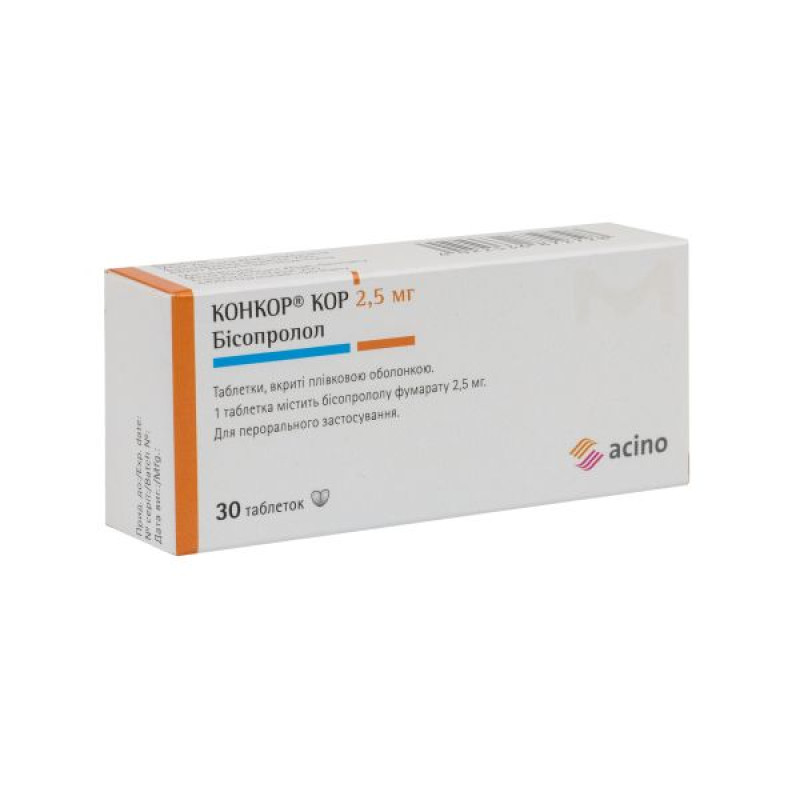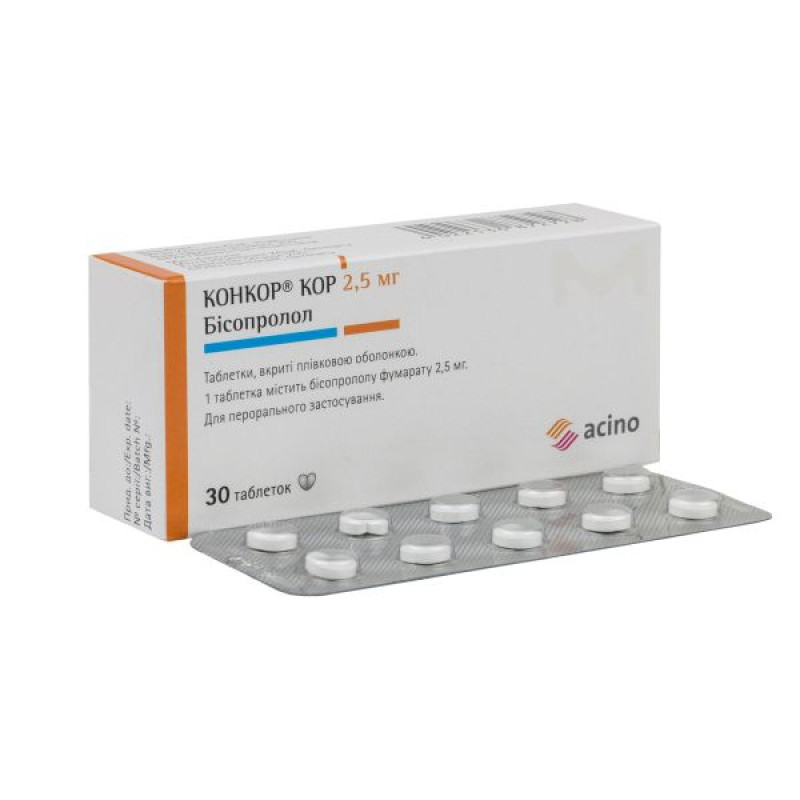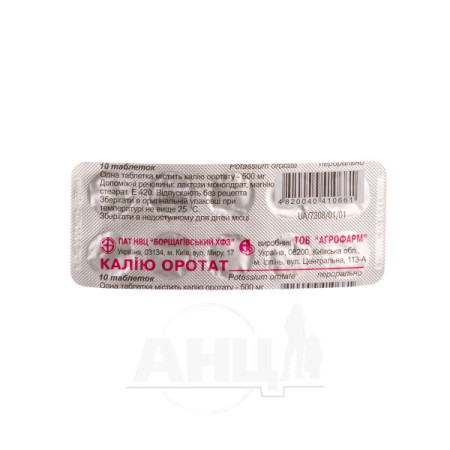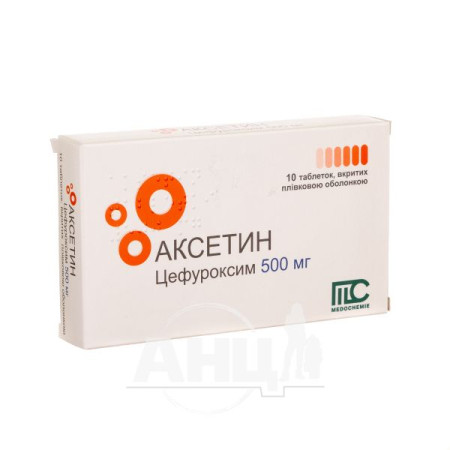Concor Cor film-coated tablets 2.5 mg blister No. 30

Instructions Concor Cor film-coated tablets 2.5 mg blister No. 30
Composition
active ingredient: bisoprolol;
1 tablet contains bisoprolol fumarate 2.5 mg;
excipients: colloidal anhydrous silicon dioxide; magnesium stearate; crospovidone; microcrystalline cellulose; corn starch; calcium hydrogen phosphate anhydrous;
film coating: hypromellose 2910/15; macrogol 400; dimethicone 100; titanium dioxide (E 171).
Dosage form
Film-coated tablets.
Main physicochemical properties: off-white, heart-shaped, biconvex, film-coated tablets, with a score on both sides.
Pharmacotherapeutic group
Selective ß-adrenergic receptor blockers.
ATX code C07A B07.
Pharmacological properties
Pharmacodynamics.
Bisoprolol is a highly selective ß1-adrenoblocker. When used in therapeutic doses, it does not have intrinsic sympathomimetic activity and clinically pronounced membrane-stabilizing properties. It has antianginal and hypotensive effects. It reduces myocardial oxygen demand by reducing heart rate and cardiac output and lowering blood pressure, increases myocardial oxygen supply by reducing end-diastolic pressure and prolonging diastole. The drug has a very low affinity for ß2-receptors of bronchial and vascular smooth muscle, as well as for ß2-receptors of the endocrine system. The drug can only in rare cases affect the smooth muscle of the bronchi and peripheral arteries, as well as glucose metabolism.
Pharmacokinetics.
Absorption: Bioavailability is about 90%.
Distribution: The volume of distribution is 3.5 l/kg. Plasma protein binding is about 30%.
Metabolism and excretion. Bisoprolol is excreted from the body in two ways: 50% is biotransformed in the liver with the formation of inactive metabolites and excreted by the kidneys, 50% is excreted by the kidneys unchanged. The total clearance of bisoprolol is 15 l/h. Due to the long half-life (10-12 hours), the drug retains its therapeutic effect for 24 hours when used once a day.
Linearity. The pharmacokinetics of bisoprolol are linear, and their parameters do not depend on age.
Special patient groups. Since bisoprolol is excreted from the body by the kidneys and liver to an equal extent, no dosage adjustment is required in patients with impaired liver function or renal function. Pharmacokinetics in patients with stable chronic heart failure and with impaired liver or renal function have not been studied. In patients with chronic heart failure of the III functional class (according to NYHA), the level of bisoprolol in the blood plasma is higher and the half-life is prolonged compared to healthy volunteers. The maximum plasma concentration in the equilibrium state is 64 + 21 ng / ml with a daily dose of 10 mg and a half-life of 17 + 5 hours.
Indication
Treatment of chronic heart failure with left ventricular systolic dysfunction in combination with ACE inhibitors, diuretics, and if necessary, cardiac glycosides.
Contraindication
Acute heart failure or heart failure in the stage of decompensation requiring intravenous inotropic therapy;
cardiogenic shock;
atrioventricular block II and III degree;
sick sinus syndrome;
sinoatrial block;
symptomatic bradycardia;
symptomatic arterial hypotension;
severe form of bronchial asthma or severe chronic obstructive pulmonary disease;
severe form of peripheral arterial occlusive disease or Raynaud's disease;
untreated pheochromocytoma;
metabolic acidosis;
hypersensitivity to bisoprolol or to other components of the drug.
Interaction with other medicinal products and other types of interactions
Combinations that are not recommended for use.
Calcium antagonists (verapamil group, to a lesser extent diltiazem): negative effect on myocardial contractile function and atrioventricular conduction. Intravenous administration of verapamil in patients taking ß-blockers may lead to severe hypotension and atrioventricular block.
Class I antiarrhythmics (e.g. quinidine, disopyramide, lidocaine, phenytoin, flecainide, propafenone): possible potentiation of the effect on atrioventricular conduction and increased negative inotropic effect.
Hypotensive drugs with a central mechanism of action (clonidine, methyldopa, moxonidine, rilmenidine): possible worsening of the course of heart failure due to a decrease in central sympathetic tone (decrease in heart rate and cardiac output, vasodilation).
Abrupt withdrawal of the drug, especially if it is preceded by withdrawal of β-adrenergic blockers, may increase the risk of rebound hypertension.
Combinations that should be used with caution.
Class III antiarrhythmic drugs (e.g. amiodarone): possible potentiation of the effect on atrioventricular conduction.
Topical ß-blockers (e.g. contained in eye drops for the treatment of glaucoma): possible enhancement of the systemic effects of bisoprolol.
Parasympathomimetics: possible increase in atrioventricular conduction time and increased risk of bradycardia.
Insulin and oral hypoglycemic agents: potentiation of the hypoglycemic effect. Blockade of ß-adrenoceptors may mask the symptoms of hypoglycemia.
Anesthetic agents: weakening of reflex tachycardia and increased risk of arterial hypotension.
Cardiac glycosides: decrease in heart rate, increase in atrioventricular conduction time.
Non-steroidal anti-inflammatory drugs (NSAIDs): possible weakening of the hypotensive effect of bisoprolol.
ß-sympathomimetics (e.g. isoprenaline, dobutamine): possible reduction in the therapeutic effect of both agents.
Sympathomimetics that activate α- and β-adrenergic receptors (e.g. adrenaline, noradrenaline): α-adrenergic mediated vasoconstriction may occur, leading to increased blood pressure and increased intermittent claudication. This interaction is more likely with non-selective β-blockers.
When used concomitantly with antihypertensive agents and agents with hypotensive effects (e.g. tricyclic antidepressants, barbiturates, phenothiazines), the risk of arterial hypotension may be increased.
Possible combinations.
-Mefloquine: possible increased risk of bradycardia.
MAO inhibitors (except MAO inhibitors type B): increased hypotensive effect of ß-blockers, but there is a risk of developing hypertensive crisis.
Application features
Treatment of stable chronic heart failure with bisoprolol should begin with a titration phase.
In patients with coronary heart disease, treatment should not be stopped abruptly unless absolutely necessary, as this may lead to transient deterioration of the condition. Initiation and discontinuation of bisoprolol treatment requires regular monitoring.
Currently, there is insufficient therapeutic experience in the treatment of chronic heart failure in patients with the following diseases and pathological conditions: type 1 diabetes mellitus, severe renal impairment, severe hepatic impairment, restrictive cardiomyopathy, congenital heart disease, hemodynamically significant valvular heart disease, myocardial infarction within the last 3 months.
The drug should be used with caution in patients with the following conditions:
bronchospasm (in bronchial asthma, obstructive airway diseases);
diabetes with significant fluctuations in blood glucose levels; symptoms of hypoglycemia may be hidden;
strict diet;
desensitization therapy. Like other ß-blockers, bisoprolol may increase sensitivity to allergens and increase the severity of anaphylactic reactions. In such cases, treatment with adrenaline does not always give a positive therapeutic effect;
atrioventricular block I degree;
Prinzmetal's angina;
Obliterating peripheral arterial diseases (at the beginning of therapy, complaints may worsen);
general anesthesia.
It is necessary to warn the anesthesiologist about the use of ß-adrenergic blockers. In patients who are scheduled for general anesthesia, the use of ß-blockers reduces the incidence of arrhythmia and myocardial ischemia during induction of anesthesia, intubation and the postoperative period. It is recommended to continue the use of beta-blockers during the perioperative period. The anesthesiologist should take into account the potential interaction with other drugs, which can lead to bradyarrhythmia, reflex tachycardia and a decrease in the ability of the reflex mechanism to compensate for blood loss. In case of discontinuation of bisoprolol before surgery, the dose should be gradually reduced and the drug should be discontinued 48 hours before general anesthesia.
Combinations of bisoprolol with calcium antagonists of the verapamil or diltiazem group, with class I antiarrhythmic drugs and with centrally acting antihypertensive agents are not recommended (see section "Interaction with other medicinal products and other types of interactions").
In bronchial asthma or other chronic obstructive pulmonary diseases, concomitant therapy with bronchodilators is indicated. In some cases, while taking the drug, patients with bronchial asthma may require higher doses of ß2-sympathomimetics due to increased airway resistance.
Patients with psoriasis (including those with a history of psoriasis) are prescribed ß-blockers after a careful benefit/risk assessment.
Patients with pheochromocytoma are prescribed bisoprolol only after treatment with α-blockers.
Symptoms of thyrotoxicosis may be masked by the use of bisoprolol.
Use during pregnancy or breastfeeding
Pregnancy. Bisoprolol has pharmacological properties that may cause harmful effects on the course of pregnancy and/or the development of the fetus/newborn. As a rule, ß-blockers reduce placental blood flow, which can cause intrauterine growth retardation, intrauterine death, spontaneous abortion or premature birth. Adverse effects in the fetus and newborn (e.g. hypoglycemia, bradycardia) may develop. If treatment with ß-blockers is necessary, it is preferable that it be a ß1-selective adrenoblocker.
During pregnancy, the drug should be used only if the expected benefit to the mother outweighs the potential risk to the fetus. It is necessary to monitor uteroplacental blood flow and fetal growth. In case of harmful effects on the course of pregnancy or the fetus, alternative treatment should be considered.
After delivery, the newborn should be closely monitored. Symptoms of hypoglycemia and bradycardia can be expected during the first 3 days.
Breastfeeding. There is no data on the excretion of bisoprolol into breast milk, therefore it is not recommended to use bisoprolol during breastfeeding.
Ability to influence reaction speed when driving vehicles or other mechanisms
In studies of patients with coronary heart disease, the drug did not affect the ability to drive.
In some cases, the drug may affect the ability to drive or operate complex mechanisms. Particular attention should be paid at the beginning of treatment, when changing the dose of the drug or when interacting with alcohol.
Method of administration and doses
Concor Cor should be taken without chewing, in the morning during breakfast, with a small amount of liquid.
Standard therapy for chronic heart failure: ACE inhibitors or angiotensin II antagonists, ß-adrenoceptor blockers, diuretics and, if necessary, cardiac glycosides.
At the beginning of treatment with bisoprolol, the patient should not have signs of exacerbation. Transient worsening of heart failure, hypotension or bradycardia may occur during and after the titration period.
Dose titration period.
Treatment of chronic heart failure with bisoprolol is initiated according to the following titration schedule and may be adjusted depending on individual body responses.
– 1.25 mg bisoprolol fumarate once daily for 1 week, if well tolerated, increase to
– 2.5 mg bisoprolol fumarate once daily for the next 1 week, if well tolerated, increase to
– 3.75 mg bisoprolol fumarate once daily for the next 1 week, if well tolerated, increase to
– 5 mg bisoprolol fumarate once daily for the next 4 weeks, if well tolerated, increase to
– 7.5 mg bisoprolol fumarate once daily for the next 4 weeks, if well tolerated, increase to
– 10 mg of bisoprolol fumarate once daily as maintenance therapy.
The maximum recommended dose of bisoprolol fumarate is 10 mg once daily.
During the titration period, careful monitoring of vital signs (blood pressure, heart rate) and symptoms of progressive heart failure is necessary. Symptoms may develop from the first day after the start of treatment.
Treatment modification.
If the maximum recommended dose is not tolerated, a gradual dose reduction is possible. If worsening of heart failure, hypotension or bradycardia develops during or after the titration period, it is recommended to adjust the dosage of the drug, which may require a temporary reduction in the dosage of bisoprolol or discontinuation of treatment. After stabilization of the patient's condition, the possibility of reinitiating bisoprolol treatment should always be considered.
The course of treatment of stable chronic heart failure with bisoprolol is long.
Do not stop treatment suddenly or change the recommended dosage without consulting your doctor, as this may worsen the patient's condition. If necessary, treatment with the drug should be discontinued slowly, gradually reducing the dose.
Patients with impaired liver or kidney function.
There are no data on the pharmacokinetics of bisoprolol in patients with chronic heart failure concomitant with impaired liver or kidney function, therefore, increasing the dose should be done with extreme caution.
Elderly patients do not require dose adjustment.
Children
There are no clinical data on the efficacy and safety of the drug for the treatment of children, therefore bisoprolol is not recommended for use in pediatric practice.
Overdose
In case of overdose (for example, using a daily dose of 15 mg instead of 7.5 mg), cases of third-degree atrioventricular block, bradycardia and dizziness have been recorded. The most common signs of overdose with ß-blockers are bradycardia, hypotension, acute heart failure, hypoglycemia and bronchospasm. Currently, several cases of overdose (maximum dose - 2000 mg) of bisoprolol are known. Bradycardia or hypotension were noted. All patients recovered. There is a wide variability in individual sensitivity to a single high dose of bisoprolol, patients with heart failure may be more sensitive to the drug. Therefore, treatment should be started with a gradual increase in dosage (see section "Method of administration and dosage").
In case of overdose, you should immediately consult a doctor.
In case of overdose, treatment with the drug is discontinued and supportive and symptomatic therapy is carried out. There is limited evidence that bisoprolol is difficult to dialyze. In case of suspected overdose, in accordance with the expected pharmacological action and based on recommendations for other ß-blockers, the following general measures should be considered.
For bradycardia: intravenous atropine. If there is no response, isoprenaline or another drug with a positive chronotropic effect should be administered with caution. In exceptional cases, transvenous implantation of an artificial pacemaker may be necessary.
For hypotension: intravenous fluids and vasoconstrictors. Intravenous glucagon may be useful.
In case of second and third degree atrioventricular block: careful observation and infusion of isoprenaline or transvenous pacemaker.
In case of exacerbation of chronic heart failure: intravenous administration of diuretics, inotropic drugs, vasodilators.
For bronchospasm: bronchodilators (e.g. isoprenaline), ß2-adrenomimetics and/or aminophylline.
For hypoglycemia: intravenous glucose administration.
Adverse reactions
Adverse effects are classified according to the frequency of occurrence into the following categories:
very common (> 1/10), common (> 1/100 and < 1/10), uncommon (> 1/1000 and < 1/100), rare (> 1/10000 and < 1/1000), very rare (< 1/10000).
From the cardiovascular system.
Very common: bradycardia.
Common: worsening of heart failure, feeling of coldness or numbness of the extremities, hypotension.
Uncommon: atrioventricular conduction disturbances, orthostatic hypotension.
From the nervous system.
Common: dizziness, headache.
Rare: fainting.
From the organs of vision.
Rare: decreased tear production (should be taken into account when wearing contact lenses).
Very rare: conjunctivitis.
From the side of the hearing organs.
Rare: hearing impairment.
On the part of the respiratory system.
Uncommon: bronchospasm in patients with a history of bronchial asthma or obstructive airways disease.
Rare: allergic rhinitis.
From the digestive tract.
Common: nausea, vomiting, diarrhea, constipation.
From the skin.
Rare: hypersensitivity reactions (itching, redness, rash).
Very rare: alopecia. Treatment with ß-blockers may cause worsening of psoriasis in the form of psoriatic rash.
On the part of the musculoskeletal system.
Uncommon: muscle weakness, cramps.
From the liver.
Rare: hepatitis.
From the reproductive system.
Rare: impotence.
Mental disorders.
Uncommon: depression, sleep disorders.
Rare: nightmares, hallucinations.
Laboratory indicators.
Rare: increased blood triglyceride levels, increased activity of liver enzymes in blood plasma (AST, ALT).
General disorders.
Common: asthenia, fatigue.
Expiration date
3 years.
Storage conditions
Store in original packaging at a temperature not exceeding 25 ° C. Keep out of the reach of children!
Packaging
10 tablets in a blister; 3 blisters in a cardboard box.
Vacation category
According to the recipe.
Manufacturer: Merck KGaA, Germany.
Location of the manufacturer and its business address.
Frankfurter Strasse 250, 64293 Darmstadt, Germany/Frankfurter Strasse 250, 64293 Darmstadt, Germany.
There are no reviews for this product.
There are no reviews for this product, be the first to leave your review.
No questions about this product, be the first and ask your question.













